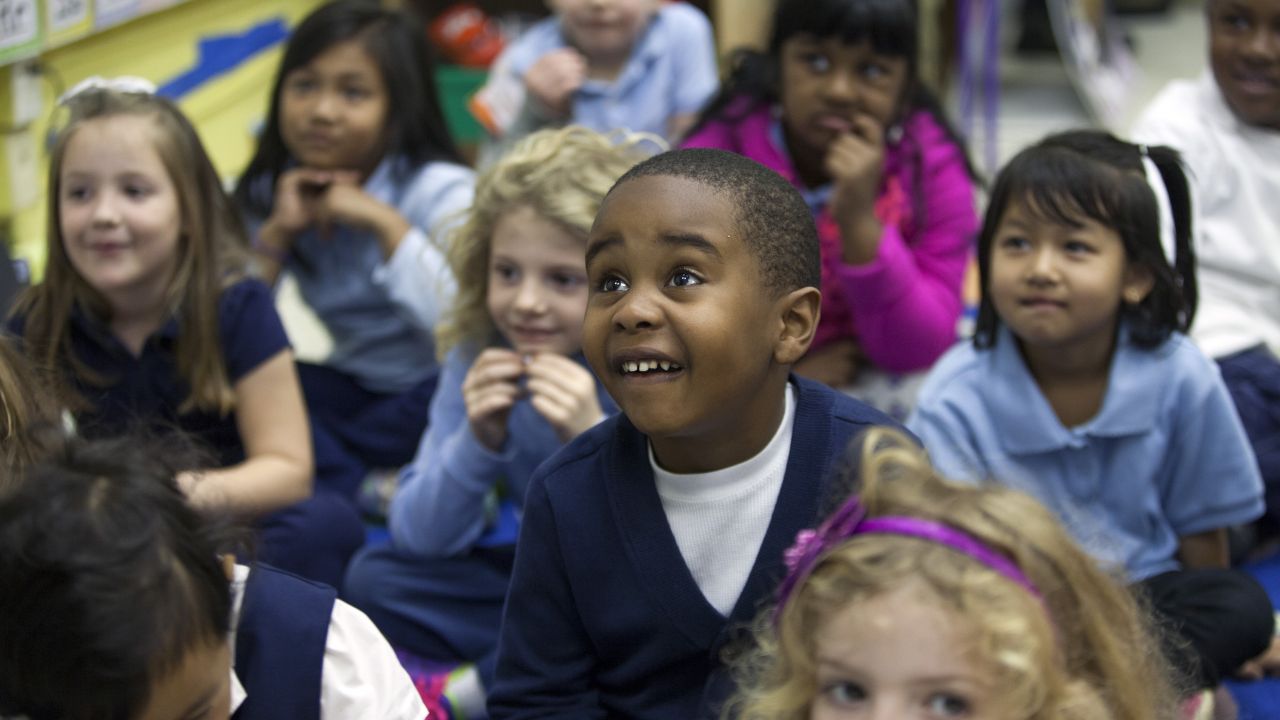
Students in kindergarten listen to their principal read a book at the International Community School on December 17, 2015 in Decatur, Georgia. The elementary school, a public charter school for grades K-5, has about 400 students from 30 nations speaking 25 languages. ICS was strategically designed in 2002 to bring together refugee, immigrant and local children in an academically challenging and nurturing environment. The surrounding community is noted for its ethnic diversity. (Photo by Melanie Stetson Freeman/The Christian Science Monitor via Getty Images)
The Black Lives Matter movement has drawn much-needed national and worldwide attention to the deaths of African-Americans at the hands of those sworn to protect them, igniting a long-overdue discussion about the systemic injustices African-Americans face in the realms of policing and criminal justice.
As a society, however, we need to take that discussion a step further. We must acknowledge the obvious fact that black lives of all ages matter. Among other things, this means putting a stop to the harm inflicted upon millions of young black (and brown) lives by an education system that from the very start stacks the odds against children of color.
Disparities in education begin at an early age. Research affirms the critical importance of children’s access to enriching, stimulating early experiences for healthy brain development. Yet young African-American children lag behind their white counterparts by an estimated 15 percent versus 24 percent in access to high-quality programs. While in recent decades new investments in state-funded pre-K programs and others have helped shrink the gap, data from the Department of Education’s Office of Civil Rights (OCR) reveals that black preschoolers are nearly twice as likely as their white peers to be suspended from preschool.
Yes, you read that right. Children for whom water guns and balloons constitute lethal weapons are being expelled in substantial numbers from their sandboxes and reading corners.
Those same children then enter kindergarten classrooms that are heavily segregated by race and social class — the classrooms least likely to help lay a strong foundation for future school success. Data show that among kindergarteners who began school in 2010-11, most white students were in classrooms in which only around 1 in 10 of their classmates was poor and no more than a quarter were minorities. Over half of black and Hispanic students, in contrast, began their school careers in classrooms in which about half the children were poor and at least three-fourths minorities.
Yet the schools serving those students are poorly equipped to counter these disadvantages, and to support teachers’ added needs. Systemic inequities in school funding, which tend to channel more resources to wealthier districts and students, are further exacerbated by race. In Pennsylvania, for example, which has one of the nation’s most inequitable funding schemes, schools in which 50-60 percent of students are low-income spend $6,241 per student if those students are mostly white, versus just $3,634 if they are black. Such meager resources for heavily minority schools and districts are a major cause of stark disparities in qualifications, experience and other measures of teacher quality among educators of black versus non-black students.
Biases against young men of color that have surfaced in police statistics are more widespread than these indicate and have their origins much earlier. Office of Civil Rights data also document that harsh discipline policies that lead students to drop out — including out-of-school suspensions, expulsions and referrals to police — fall disproportionately on African-American students. Moreover, while much of the public perceives these as necessary corrective measures for students who bring weapons to school or threaten a teacher, news reports suggest that the same kind of broad discretion afforded police enables school administrators to channel students into the school-to-prison pipeline even for pointing their fingers as if they were a gun — classic elementary school behavior — or “talking back.”
As academic standards become more rigorous and an increasing share of jobs demand at least some post-secondary education, competition for entry into selective colleges has exploded. Yet the high-level courses and school counselors critical to helping students successfully navigate the application process are not available for many students of color. And problems are far more basic than inability to access Advanced Placement classes; OCR data reveal that “a quarter of high schools with the highest percentage of black and Latino students do not offer Algebra II; a third of these schools do not offer chemistry.”
Capping it all off, for-profit colleges have been cashing in on the desperation of low-income and, especially, minority students by targeting inaccurate and outright predatory marketing campaigns at their communities. Materials from exorbitantly expensive, for-profit institutions like Corinthian Colleges and University of Phoenix promise great faculty, connections and access to good-paying jobs but deliver mostly debt and dead ends.
So we need to start having conversations about how much black lives matter in preschool, if not earlier. We must advance policies that prevent the relegation of children of color to kindergarten classrooms filled with other children who face tough odds and whose parents can bring few resources to bear on improving teaching and learning conditions. If public schools are to be a true cornerstone of our democracy, we must demand that they are funded equitably, according to their needs, not their parents’ — and ZIP codes’ — ability to pay.
There should be zero tolerance for any policies that set 11-year-olds on a fast track to prison for a schoolyard scuffle, or that consign students to schools with broken windows, lead-poisoned water and no accredited algebra, chemistry or music teachers.
Putting in place policies affirming that black lives of all ages matter would substantially improve the chances to succeed in school and higher education — and we’ll all be the better for it.




